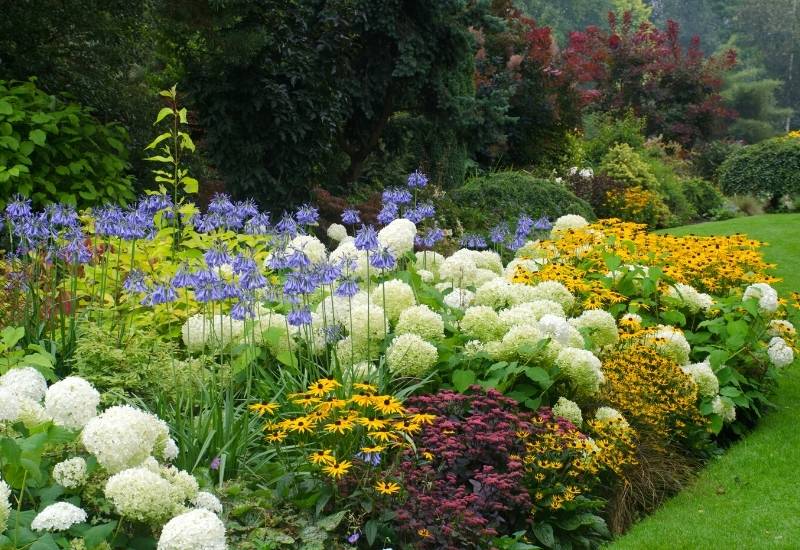
Whether you grow your perennials in your garden bed, border, or container, one thing is sure: you don’t want deer munching on them. If you live in an area where deer live, you will know the feeling…
One day you walk out, and where you had rich and lush foliage, you find holes so big you can see through them!
Sadly, there is no such thing as a deer-proof flowers but there are few that considered as deer-resistant. What puts deer off some perennial plants can be the pungent smell, fuzzy leaf texture, or the fact that they are literally poisonous for them.
Picking deer-repelling perennials for your garden is an important choice because flowers that deter deer and do well in some areas may not work in yours. So you need to read plant tags carefully to choose ones that are suited to your garden conditions, such as hardiness zone sun exposure, soil type.
To help you narrow down your choices, I rounded up 20 of the best deer-resistant perennial plants and flowers suited for a variety of climates and growing conditions (for sun or shade), along with tips on how and where to plant them in your garden.
Do You Need Deer Resistant Perennials?
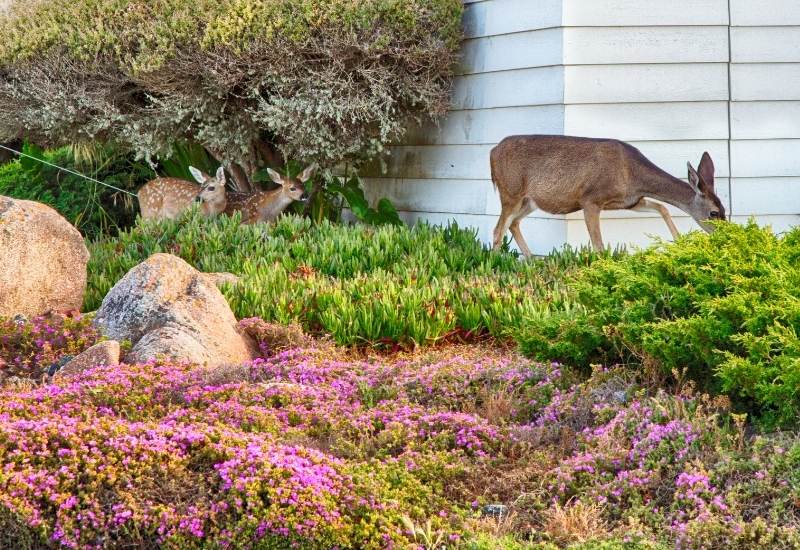
Let’s be honest, some people may not care at all if a perennial or any other plant is deer resistant! Why? Because there are no deer where they live!
Deer like fresh places, away from urban centers and with a lot of green spaces. They need open fields as well as forests to call a place home. They can’t stand very hot places, nor do they like dry places.
If you live in an urban or suburban place, deer won’t be an issue for you. But if you just move a bit out of the urban sprawl, deer will not be far off your garden, in most central and northern US states and in Canada or most of Europe!
“And if I have a fence?” Good question! If your fence is tall and strong enough, and it completely encloses your garden, you will be fine! But most rural gardens are not fenced off completely, and deer can come in also from very small openings.
And remember: they climb very well! It just takes a steep slope you use to keep passers by off. It’s fine for people, but it’s a child’s game for deer…
Now you know if you need deer resistant perennials, let’s see how you can make the best of them.
Choosing Perennial Plants To keep deer out of your garden
We can divide deer resistant perennials into two functions, or uses. Some are plants that deer will simply ignore. They won’t eat them, but they will not be deterred by them.
The second group is perennials that deer find repulsive or even dangerous. These will actually keep deer away from the plants that grow next to them. Let me explain.
We said that there are three main reasons why deer will not like some plants: the leaf texture will simply make them overlook the plant. But plants that are toxic to them will literally scare them.
So, they may end up avoiding your garden altogether. How about the plants that have smells deer don’t like? If there are many together, or if the smell is strong enough, they can work as a deterrent too!
You don’t need to plant only deer resistant perennials, Just mix in deer resistant perennials with other plants. If deer do come, they won’t destroy the whole of your borers and flower beds.
But if you use enough deterrent plants, they will come once, look around, maybe chew on a few leaves, but they will decide it’s not an inviting place for them and leave you alone after that!
Ok, now you are well equipped to use deer resistant perennials in the best possible way. Shall we start with the first group, deer resistant perennials for shade?
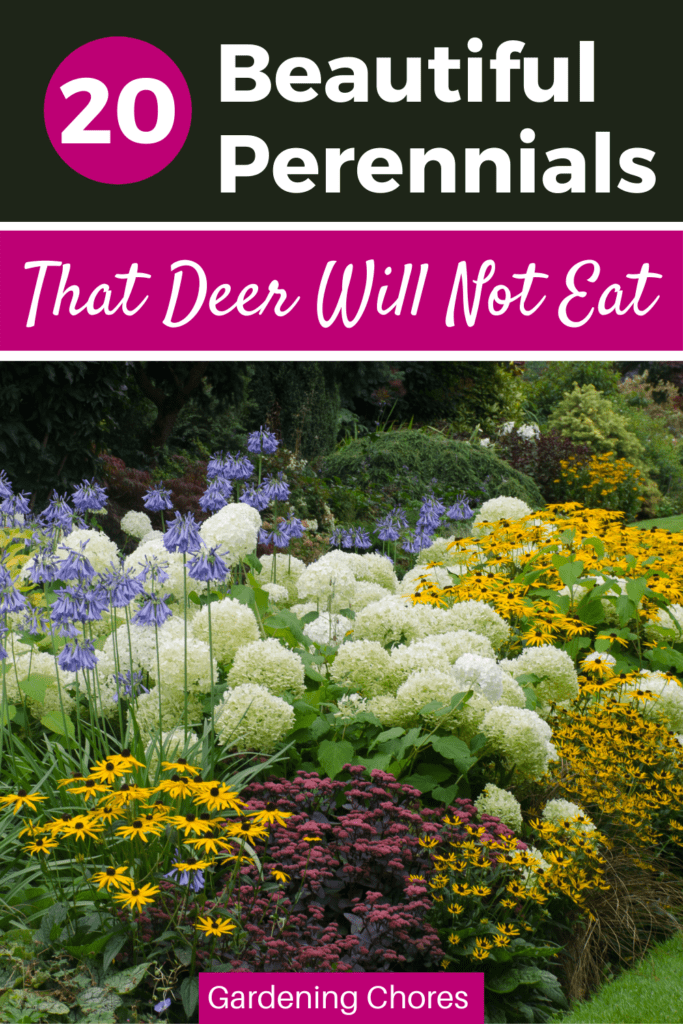
20 Best Deer-Resistant Perennial Plants And Flowers for Your Garden
“So what’s this short list going to be like?” I’m not going to keep you guessing: Here are the 20 most beautiful and easy to grow perennials that deer don’t usually eat or even keep away from them.
Deer Resistant Flowering Perennials For Shade
I wish to start with deer resistant perennials for shade, and I am about to tell you why. The first reason is that if you have a garden with lots of shade, you won’t be able to plant many annuals and you will mainly rely on perennials. This is because very few annuals like partial, full or heavy shade.
For this reason, you will need to keep the visiting deer away using perennials.
But even if you have a garden with plenty of sunlight, most places have some areas that are not well lit. For this reason, maybe our list of deer resistant perennials for shade is more useful than the next, the sun ones…
Now note that by “shade” we mean partial of full shade. We don’t include light and dappled shade, but partials shade yes. Why? Partial shade is far more common than full shade.
It means that the pace receives between 3 and 6 hours of bright light a day. That is bright light, not even direct light! Full shade places, where you get less than 3 hours if bright light a day are quite rare.
The light you get in most sunny countries, even if indirect, counts as bright, to give you an idea.
Now this is clear, let’s go ahead with our deer resistant perennials for shade!
1: Columbine (Aquilegia vulgaris)
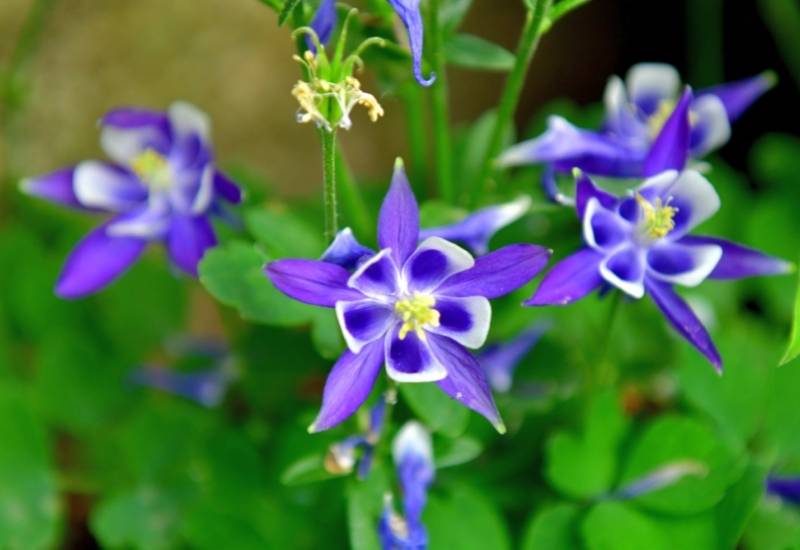
Columbines love shady places under trees and they are not afraid of deer! They will attract lots of humming birds, bees and butterflies on the other hand.
Their originally shaped flowers can be of a wide range of colors, from white to purple via blue and pink. There are also bicolor varieties, and the elegant foliage is a beauty to behold too.
Because it’s a common garden flower, there are many cultivars to choose from.
Deer like shady spots under trees… Surprise them with some columbines and they will not touch those lovely leaves nor flowers. The extra bonus is that columbines naturalize very quickly. You can soon have a carpet of plants deer don’t like under your trees.
2: Abelia (Abelia spp.)
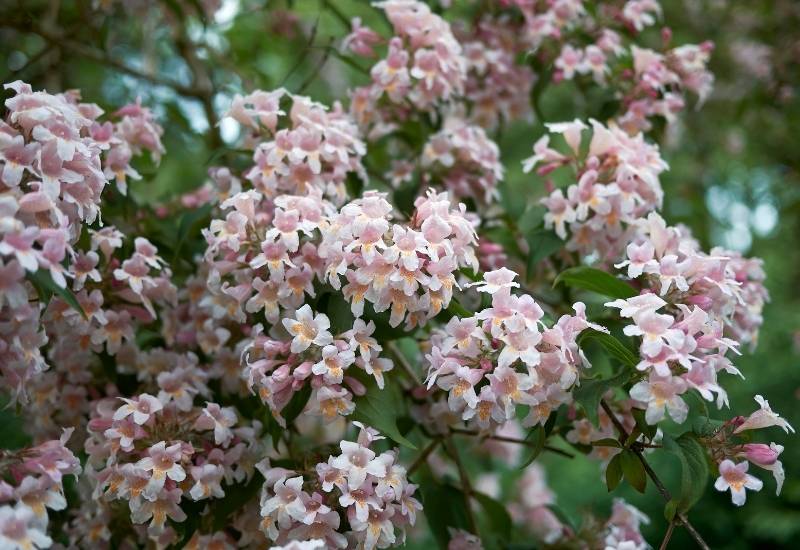
Abelia is a beautiful perennial flowering shrub which deer do not like at all. They bloom with bell shaped flowers will last for months. They start in summer and last till the first frost. These can be pink, white or lavender.
The leaves are small but very beautiful, oval and glossy. The ‘Edward Goucher’ cultivar has won the ambitious Award of Garden Merit by the Royal Horticultural Society thanks to its lavender flowers set against dark green and bronze foliage.
Abelia is an ideal plant if you want a deer proof hedge. The foliage is thick and it is easy to prune. It will prefer part shade, but in fresh regions it will not mind full Sun positions. So, even under trees or near walls, Abelia is the shrub you want, but deer don’t.
3: Dead Nettle (Lamium spp.)
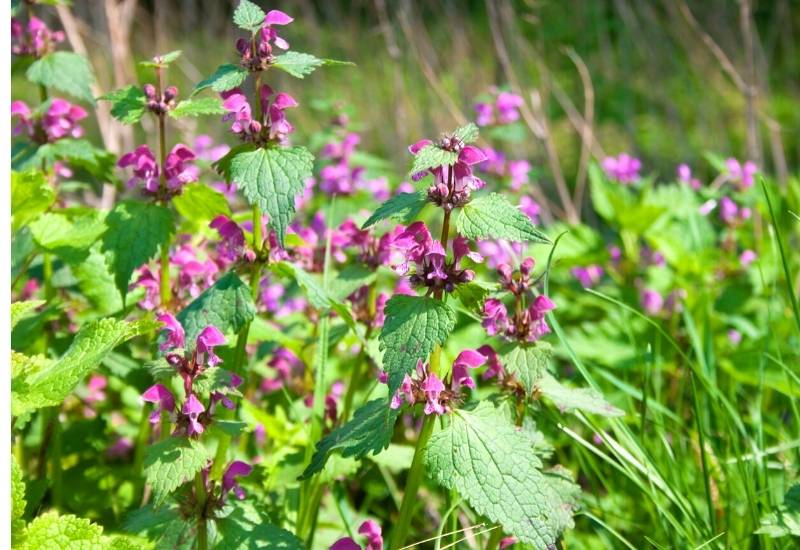
Dead nettle is a plant we can eat raw in salads, it is medicinal, it likes even deep shade, but no deer will ever eat it. Like many medicinal plants, deer seem to keep away from them.
There are wild varieties but also garden cultivars, like ‘Purple Dragon’ with silver white and green leaves and magenta flowers, or ‘White Nancy’ with white flowers or ‘Elizabeth de Haas’ with large pink flowers.
You can naturalize dead nettle even in the darkest corners of your garden. So, it is an ideal perennial to keep deer away from those often forgotten bits of your garden that may invite them in unbeknown to you!
4: Dutchman’s Breeches (Decentra cucullaria)
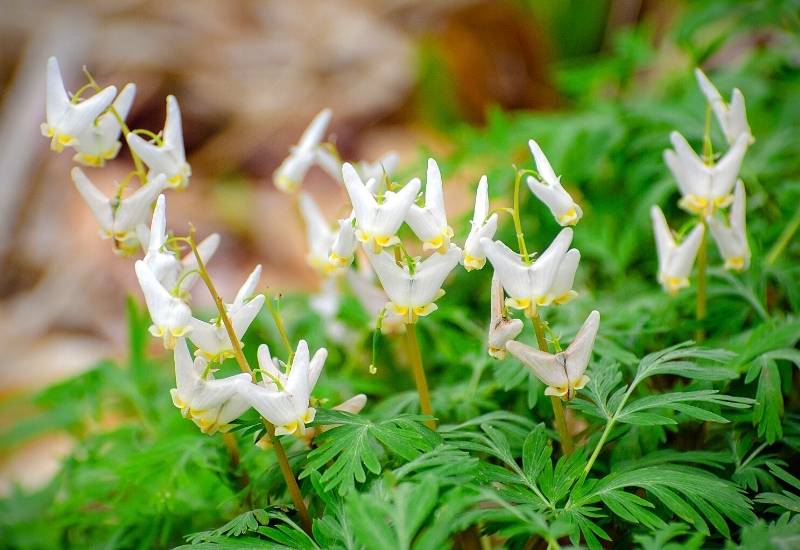
Deer don’t like Dutchman’s breeches; pity because they are unique in shape! They look like a damsel’s hat, one of those you see in fairy tale stories, or cartoons. Ok, gardeners saw “breeches” in them, but the idea is that they are very unusual.
It is also a changing plant as the leaves will disappear soon after the bloom is spent, and they will come back next spring.
If you want an original looking flowering plant for partial shade or even full shade, then you must add Dutchman’s breeches to your shortlist.
5: Lamb’s Ears (Stachys byzantina)
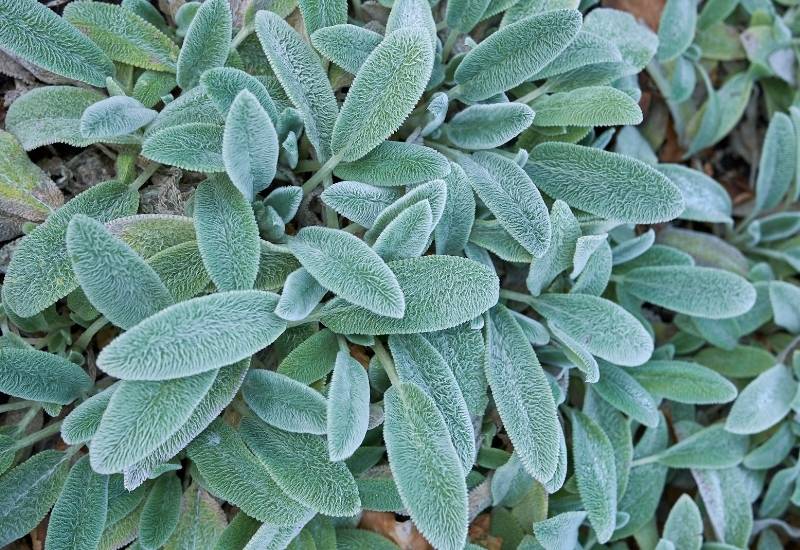
Lamb’s ears is far too fuzzy for deer to eat. The name is not a mistake; the leaves of this small plant look like long ears and they are silver blue in color and a very thick and soft looking layer of wool like hair on it.
It will spread fast over the soil, making it an excellent ground cover plant. But you never need to worry about deer with lamb’s ears… You can easily enjoy the beautiful soft carpet it forms.
Lamb’s ears is a very independent plant; you can literally forget about it once it has established itself. And the good news is, deer will forget about it too.
6: Lantern Rose (Helleborus orientalis)
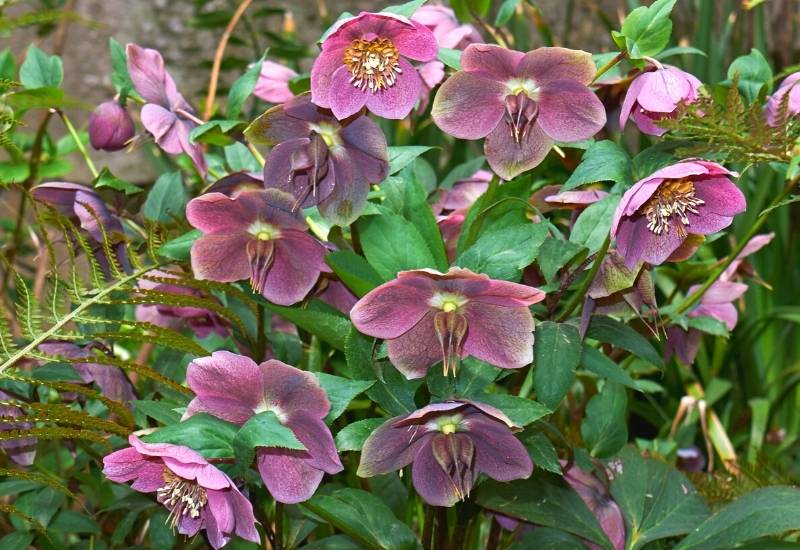
Lantern rose is a stunning plant, and it will bloom when most plants are asleep. But deer will still pass it by, despite the scarcity of food. In fact, it’s one of the earliest bloomers ever, in winter and spring.
Both flowers and leaves are wonderful, and the color range is impressive. Lantern rose “specializes” in unusual colors, like maroon or green and purple…
If you want to have showy flowers when all the world is asleep, and you don’t want deer to spoil your efforts, lantern roses are perfect, and they also naturalize very easily.
7: ‘Jack Frost’ Brunnera (Brunnera macrophylla ‘Jack Frost’)
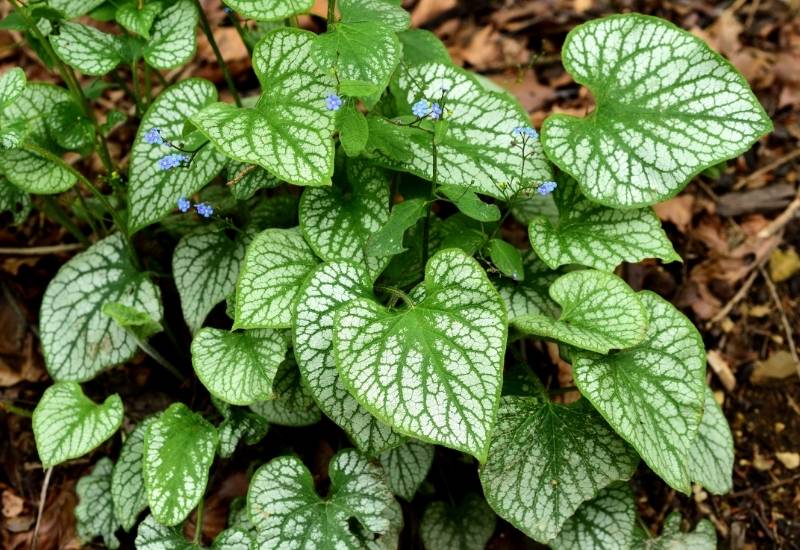
‘Jack Frost’ brunnera is a lovely perennial plant with beautiful foliage, rich and lush, excellent for ground cover but loathsome to deer.
The sky blue flowers are small but very pretty indeed; they add a lovely childish touch once a year in spring, like little eyes that float on top of the fresh looking foliage.
‘Jack Frost’ brunnera is perfect for those remote areas of your garden even in full shade, just the places deer are most likely to visit!
8: Jack in the Pulpit (Arisaema triphyllum)
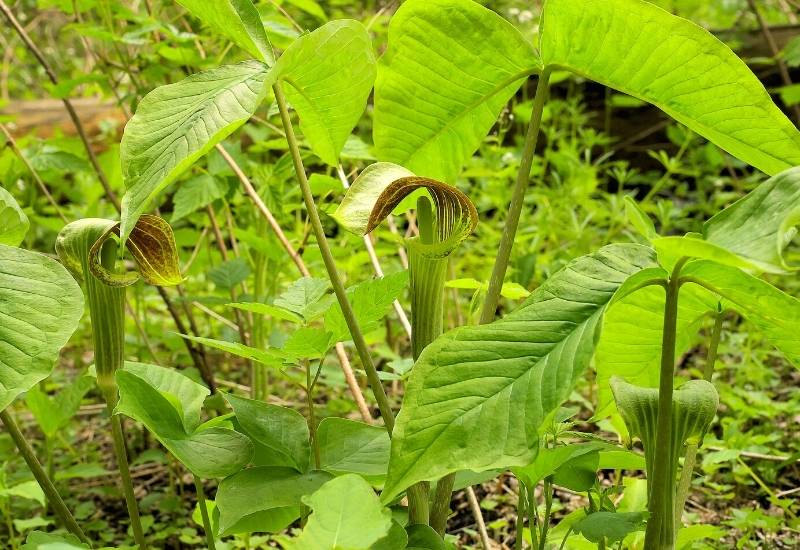
Jack in the pulpit looks like a cobra head, and that’s why deer won’t touch it! I am joking; it won’t touch it because they just don’t like it.
But it is true that they look like the heads of the poisonous Asian snakes! And the beautiful light green and almost black stripes on its back make the, even more beautiful.
It’s an excellent deer deterrent choice for shady area near your home; it’s far too beautiful to relegate to the back of your garden…
Deer-Resistant Perennials For Sun
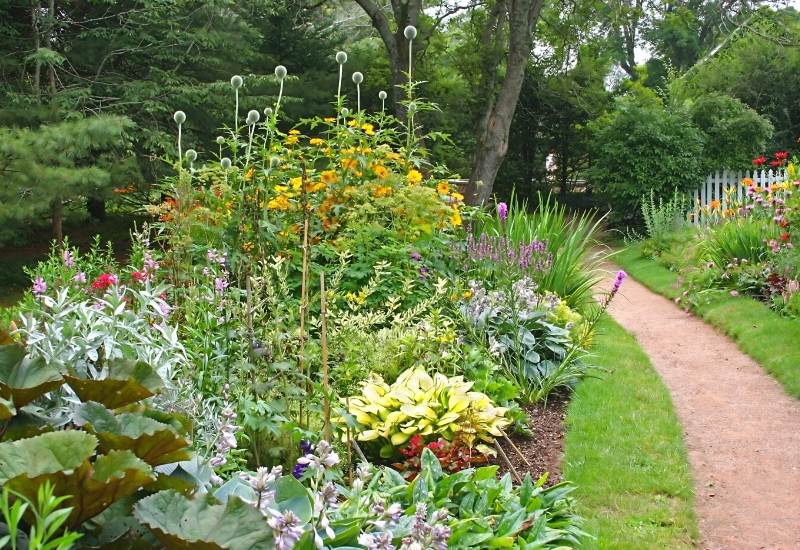
If your garden has full Sun spots, you are a lucky gardener, but deer can be a problem even there. The good news is that there are a fair few perennial plants that love to grow in full Sun conditions and that deer will not even touch.
Remember that by full Sun does not mean that you need to have 12 hours of tropical Sun! it simply means that you have more than six hours of bright light during the day, on average. That’s not too much of you think about it.
And now it’s our time to start with a shortlist of deer resistant perennials that we have out together for you. Ready? Off we go!
9: Lavender (Lavandula spp.)
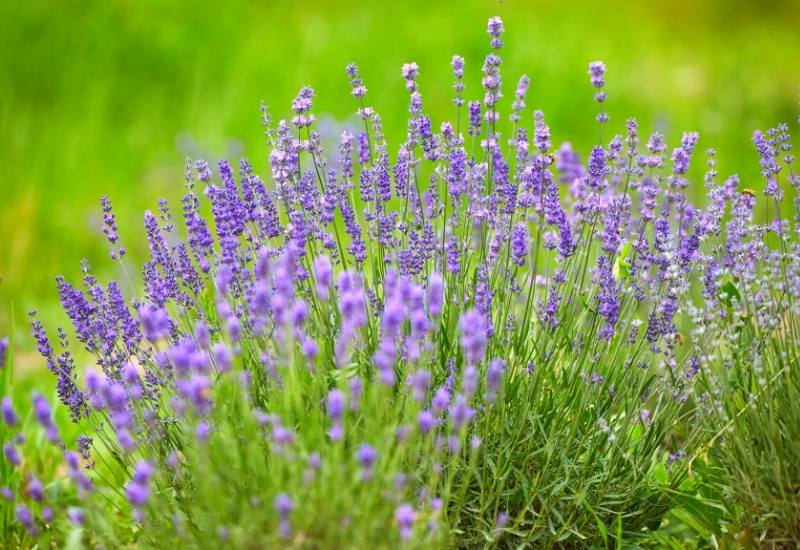
I must admit that lavender is one of may favorite plants ever, but deer totally disagree with me! The beautiful smell we love is totally disgusting to deer.
You can enjoy the wonderful blooms lavender, purple, white or magenta blooms of this special shrub for months, and the only guests will be butterflies, bees and humming birds!
Lavender is one of those aromatic herbs you can grow to deter deer altogether. It will fill your garden with wonderful colors and its amazing fragrance and that’s exactly what deer won’t stand.
10: Bearded Iris (Iris germanica)
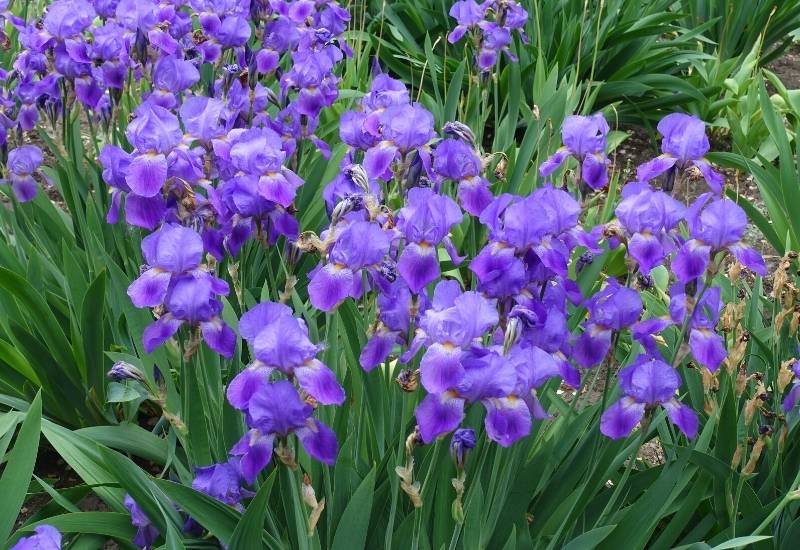
Bearded iris is a stunning sun-loving flowering plant, but is is also poisonous and deer are very much aware of this. And in fact they will never touch any if it.
The blue or green blade shaped leaves are safe from them, so are the showy flowers, whatever their color. Snd the choice is huge, from white to black purple via all the colors of the rainbow!
Bearded iris is a perfect plant to grow in borders and flower beds to tell deer to stay away from them!
11: Yarrow (Achillea spp.)
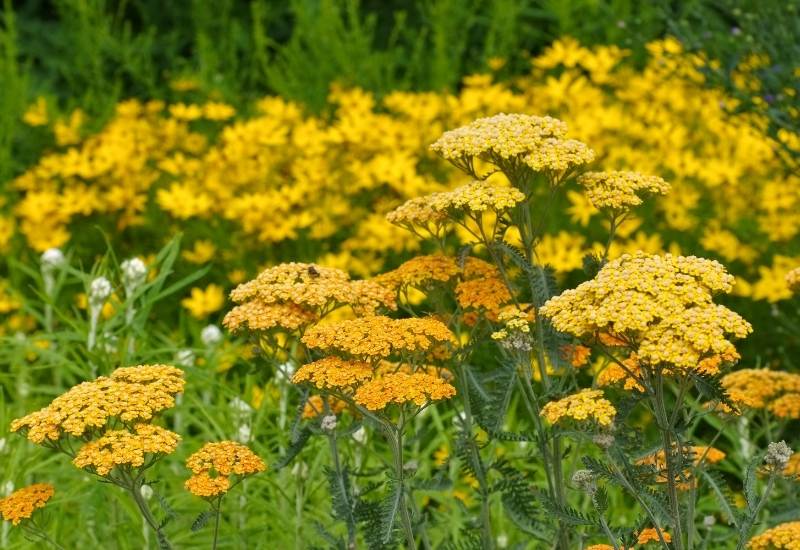
Yarrow is perfect if you want generous blooms of yellow, red, pink, magenta or orange flowers that deer find unattractive and foul smelling.
This vigorous plant has a wild and natural appearance, and it attracts butterflies and bees galore, but deer don’t like its smell nor its texture.
For this reason, yarrow is an excellent choice for large borders or prairies that you want to use as “deer barriers” as well.
12: Sunset Muskmallow (Abelmoschus manihot)
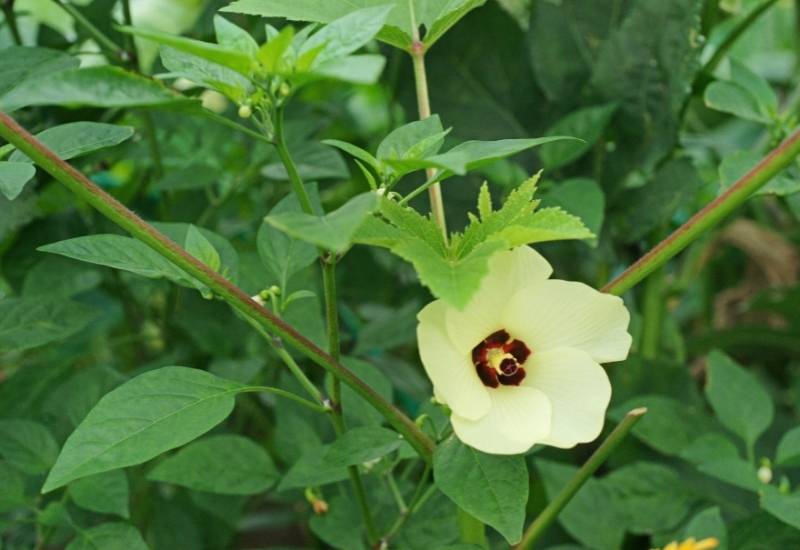
If you want a showy and exotic looking flower for your patio or front garden borders and beds that says, “Deer keep clear,” look at sunset muskmallow.
Its large pale lemon yellow flowers have a “fan” shape, and they look a bit like those of hibiscus. They can be 6 inches across (15 cm) and they grow on beautiful bushy clumps of green foliage.
This is not a cold hardy plant, so you can only grow it as a perennial in hot areas. But don’t worry if this is not your case; you can still grow it as an annual in colder regions.
13: White Fir (Abies concolor)
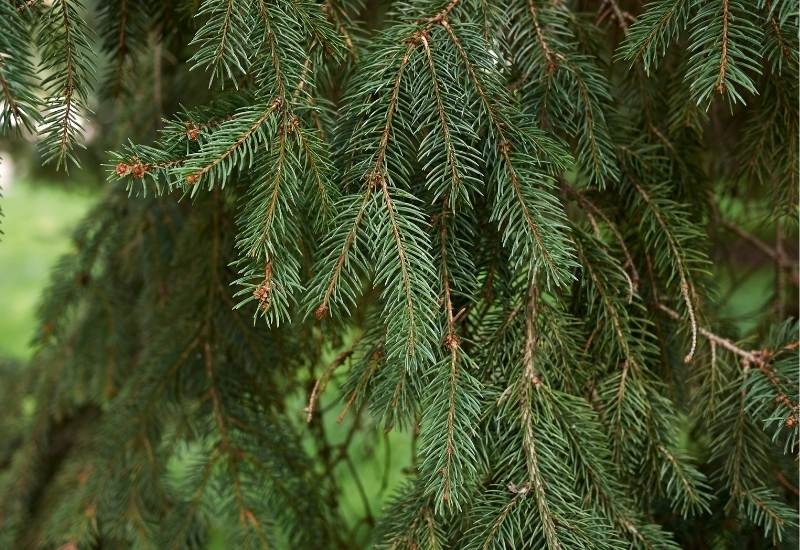
For an evergreen and fragrant plant that deer can’t stomach, I suggest white fir. There are many varieties of this beautiful conifer, all with beautiful foliage, which can be green, blue or silver, but it will stay on in winter as well.
This is a very low maintenance plant, so you needn’t spend long hours tending to it once it’s established.
14: African Lily (Agapanthus spp.)
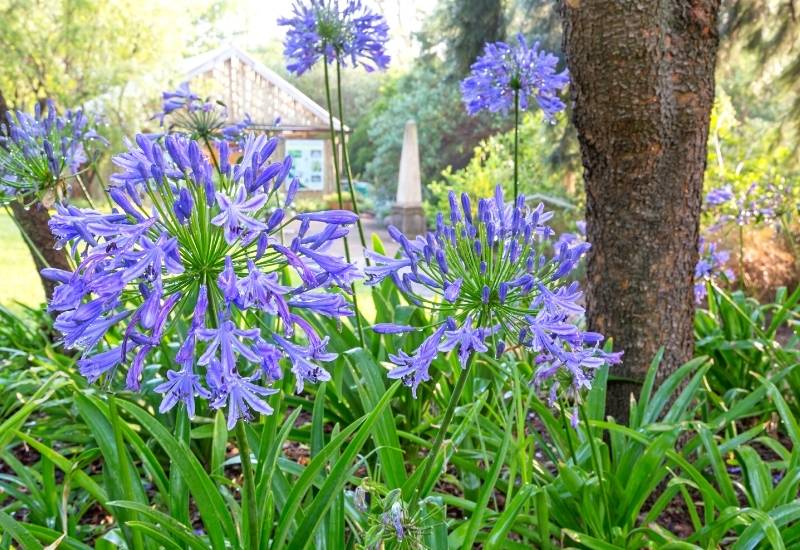
I am thinking about your deer free front garden or patio and African lily springs to mind. Its beautiful globular inflorescences are very large and showy, reaching 1 foot in diameter (30 cm).
They are usually on the blue to violet range, but white and pink varieties also exist. The long and tall leaves will shine in the Sun long after the blooms, but deer don’t like them either.
Of all full-sun deer resistant perennials, African lily is one if a few you can use in both formal and informal gardens.
15: Aloe (Aaloe spp.)
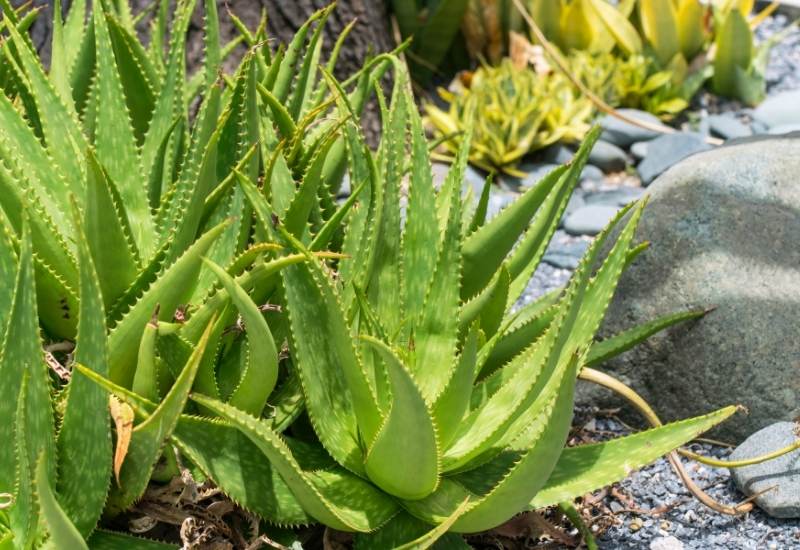
Most aloe species are disgusting to deer, did you know? Yes, the famous and soothing Aloe vera, the fiery and large torch aloe (Aloe arborescens) and even the multicolored Aloe capitata var. quartzicola with pink, aquamarine and blue leaves (!!!) are all stunning plants that deer find unappetizing…
Aloe is a Sun loving plant with many “dimensions”: it can grow in open gardens, flower beds, but also in containers on patios… It’s always stunning though!
16: Peruvian Lily (Alstroemeria spp.)
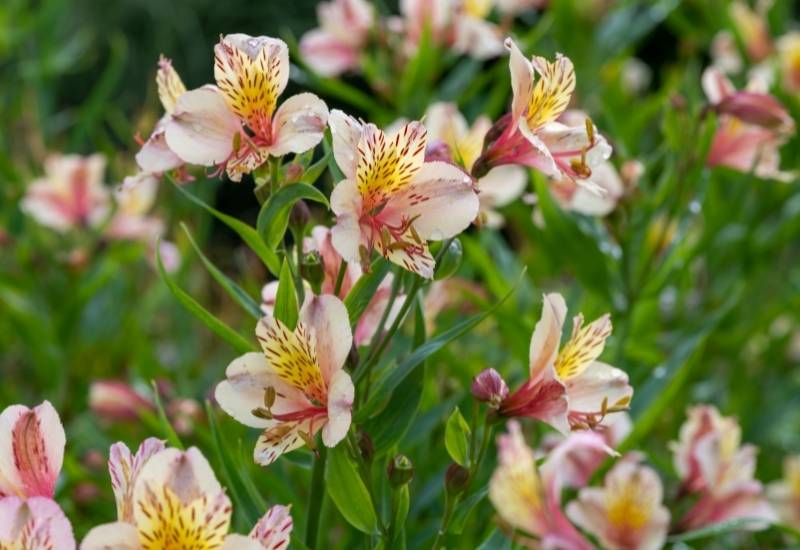
How many colors can Peruvian lilies have? And deer are “blind” to all of them! For no apparent reason, deer ignore Peruvian lilies while pollinators love them.
And so you can have all their range of warm colors and combinations in your flower beds or borders with no worries at all!
Peruvian lily is a front garden type of flower; it is showy and very decorative, suitable for borders un full sight but also sought after as cut flower.
17: White Sage (Artemisia ludoviciana)
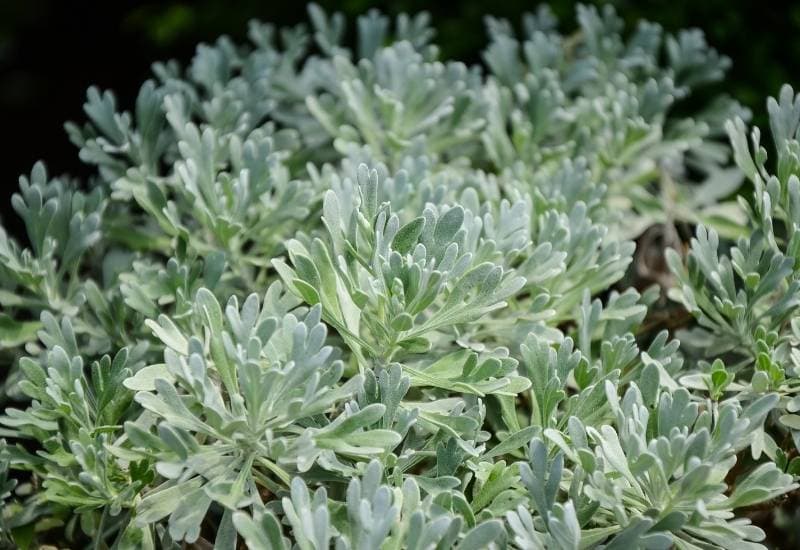
White sage is actually related to mugwort and wormwood, not sage. These deer-repelling herbs have string active ingredients we use in healing, and this is exactly what deer do not like…
It will fill your borders with aromatic silver leaves. At the tips, you will see yellow flowers in summer. The ‘Valerie Finnis’ variety has won the prestigious Award if Garden Merit by the Royal Horticultural Society.
White sage is excellent for wild looking gardens, fragrant gardens and natural looking borders. It is also suitable to coastal gardens and Mediterranean gardens.
Grow it in your wild meadow as well if you want deer to keep at a distance. In fact this plant actively deters them.
18: Agave (Agave spp.)
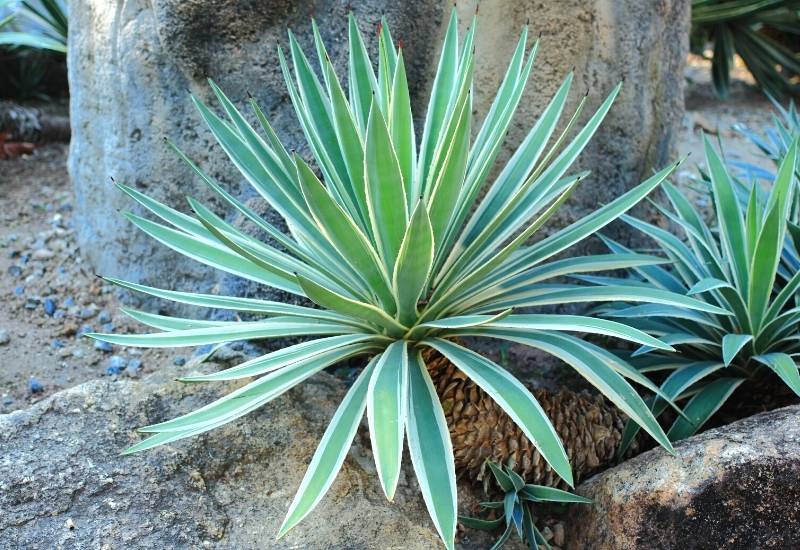
For a “living sculpture” in your garden that deer will treat with respect, choose one of the many agave varieties. In fact, these striking succulent perennials with long and shiny leaves that can be green, blue, yellow, white or variegated are not afraid of deer.
And some, like the psychedelic ‘Blue Glove” or the unusual octopus agave (Agave vilmoriniana) look like flora from Planet Mars… And deer will walk by like you do with precious statues in a museum.
The choice of agave varieties you have is large, from small plants that fit in a container to real giants.
In hot countries like Mediterranean ones they are even used as sculptural hedges around large plots of land to keep deer away, as these plants really sting you (with the tips) cut you quite deep (with the leaf sides) if you try to get through them. And trust me, the pain of an agave sting is very painful and you feel it for days!
19: African Daisy (Osteopsermum spp.)
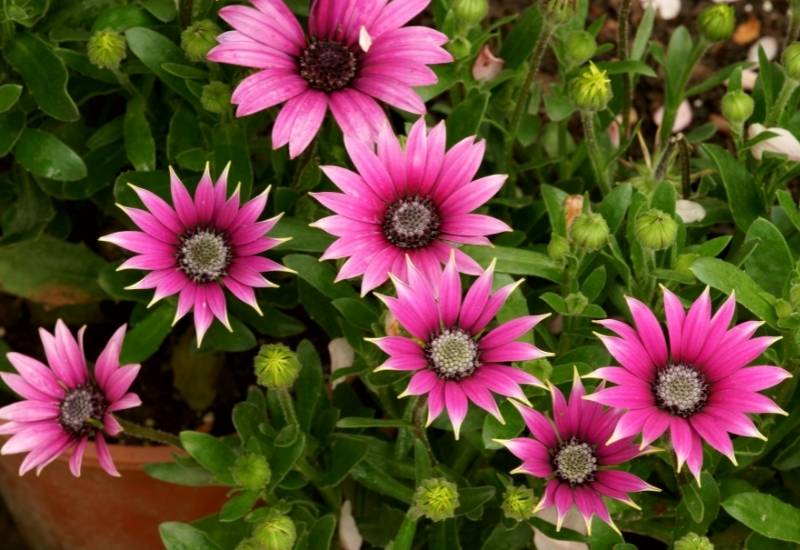
Another perfect full Sun deer resistant candidate for showy flower beds, borders or containers is African daisy.
This flowering perennial with large, showy and brightly colored flowers is becoming all the rage thanks to its long blooms, its vitality and the fact that it’s easy to grow. And deer can’t stand it.
The colors you can choose from are just splendid, from the copper orange ‘Serenity Bronze’ to the rose and white ‘Serenity Pink Magic’ there is a variety for each garden palette.
African daisy is a plant you want in a visible part of your garden. In pots on patios top it puts on a great show. A front garden would be the ideal setting.
20: Yellow Grove Bamboo (Phyllostachys aureosulcata)
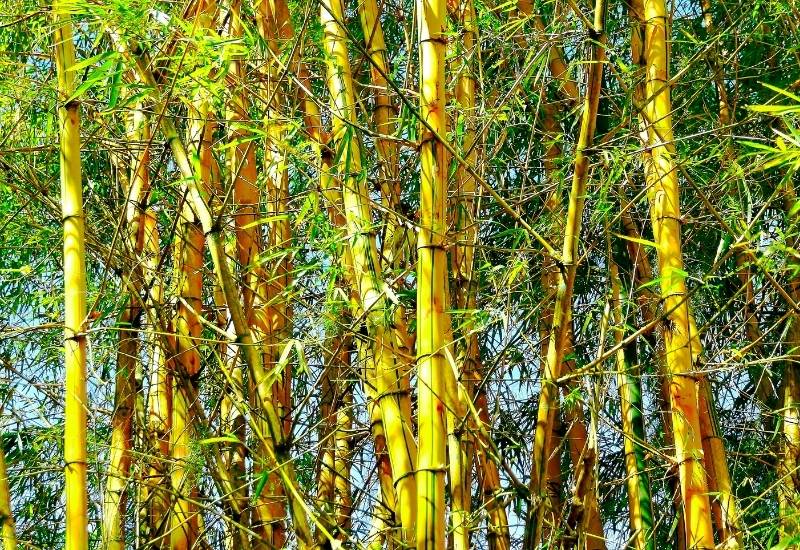
How about a deer proof bamboo grove or even a bamboo hedge deer can’t go through? Yellow grove bamboo has golden stems and green leaves, so it is very attractive.
It grows fast and thick, so it is an excellent plant to block off large areas… Grow it at the back of the garden where deer come through and you will soon have a wall against them.
And as you know, bamboo also has many other advantages and it is a very renewable material.
Yellow grove bamboo is perfect for large solutions, which is often what you need with deer. It can grow into a small tall forest in a few months. But it is so beautiful that it has won the Award of garden Merit by the Royal Horticultural Society.
Perennials Can Really Last Years, Only Without Deer!
A perennial that comes under a “deer attack” will hardly be a real “perennial”. I mean, it will at least suffer, and in most cases, you may lose your beloved plant altogether.
But now you need not panic any more! You have seen some great perennials that are totally immune to deer, and even some that keep deer at a distance.
And whether you have lots of sunlight, shade or a combination of both, you can now choose the best one(s) for you!

Written By
Amber Noyes
Amber Noyes was born and raised in a suburban California town, San Mateo. She holds a master’s degree in horticulture from the University of California as well as a BS in Biology from the University of San Francisco. With experience working on an organic farm, water conservation research, farmers’ markets, and plant nursery, she understands what makes plants thrive and how we can better understand the connection between microclimate and plant health. When she’s not on the land, Amber loves informing people of new ideas/things related to gardening, especially organic gardening, houseplants, and growing plants in a small space.

It is so disappointing to plant lovely flowers and shrubs only to find them chewed on and destroyed by deer. In my area on Long Island the deer run rampant and I had just about given up on having flowers. I am so happy to have found this site. I have hope that I can enjoy my garden again. Thank you so much.
I planted a “deer resistant” garden & all of my pink yarrow were consumed. Normally they do not bother them but I believe the extreme drought we’re experiencing currently is the cause.
I do find that they don’t eat the following perennials & shrubs not listed above:
1. Any Westringia variety
2. Any Teucrium variety
3. Society Garlic
4. Nepeta (cat mint)
5. Agastache
6. Salvia
7. Any Breath of Heaven varieties
8. Thyme, especially Wooly Thyme
9. Armeria
We just installed motion sensored sprinklers in hopes of salvaging what’s left of the Yarrow & Pittsporum. I tried using a homemade repellent but that hasn’t been a deterrent thus far.
I hope this information helps & maybe other gardeners can share what works for them.
In my area deer absolutely love Agapanthus and African Daisy. I suggest to drive around your area and see what the deer are leaving alone.
The deer eat all of our agapanthus flowers here too! They haven’t touched the Shasta daisies though, nor the Mystic Spires Blue Salvia, Little John Bottle Brush, or lavender.
I haven’t planted any yet, but the Loropetalum I see in the neighbors’ landscapes appears unscathed though I never see it on these types of lists. I’ve also noted that the deer will eat nearly any young plant, so we buy 2 gal specimens whenever possible, or nursery smaller plants ourselves until they are bigger and have woodier stems as a deterrent to the browsing (eg lantana, verbena, bouganvillea).
Regarding Loropetalum, it’s possible that the deer in your area simply haven’t discovered it yet or don’t find it as palatable as other plants. However, it’s important to remember that deer browsing habits can vary based on factors such as geographic location, time of year, and availability of other food sources. So even if Loropetalum hasn’t been affected in your area, it may still be at risk in other locations or at different times of the year.
So glad to have found this site….Have made a list of some of them and will go shopping soon.
We have a tall hedge of Arborvitae and the deer chew up as high as they can reach.
My brother has a concoction he wants me to try (on the deer!!!)
Years ago , we has beautiful Hostas until the deer became ‘city deer’ and we are only 4 blocks from the city limits.
Thanks for the help,,,,
I’m delighted to hear that you’ve found this site helpful!